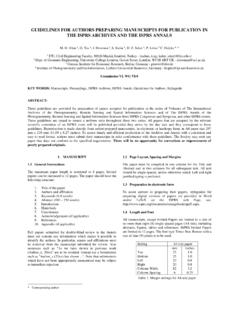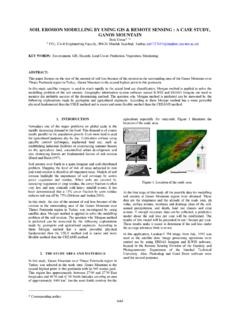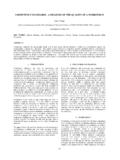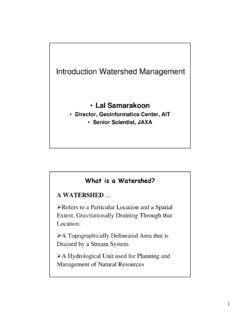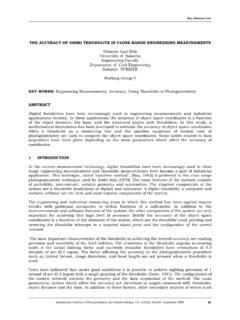Transcription of Introduction to GIS (Basics, Data, Analysis) Case …
1 1 Introduction to GIS ( basics , data , analysis )& case Studies13thMay 2004 Content Introduction to GIS data concepts data input analysis Applications selected examplesWhat is GIS?Geographic Information System (GIS) is defined as an information system that is used to input, store, retrieve, manipulate, analyze and outputgeographically referenced data or geospatial data , in order to support decision making for planning and management of land use, natural resources, environment, transportation, urban facilities, health services so is GIS?GIS is a set of tools that allow for the processing of spatial datainto information. This set of tools is open ended, but will include data input, data storage, data manipulation, and a reporting definition of GIS A GIS is designed for the collection storage, and analysis of objects and phenomena where geographic location is an important characteristic or critical to the analysis .
2 Computer tool for managing geographic feature location data and data related to those features. GIS is a tool for managing data about where features are (geographic coordinate data ) and what they are like (attribute data ), and for providing the ability to query, manipulate, and analyze those of spatial and attribute data allows users to ask unique spatial need to understand both data and software in order to create unique spatial questions and maintain spatial information produced. Facilitates analysis by providing a means to both ask complex spatial questions and store spatial data . GISC haracteristics of GISystem3 Planning & GISI nterpretation of Real World in GIS TermsEx:Locate a New Bus TerminalVillagesRoadsLand ParcelsElevationReal WorldBreak Real WorldLand UseQuestions to AnswerWhatis the needReal WorldHow farthe present users locationWhereis the present locationWhythe present need isWhatwill be the futureWherecan we have a facilityAll the above related to space or locationWhatwill be the size4 Identify the two terminals/cities Define the centerline based on topography Identify possible routes Compare with landuse Land prices Land usage restrictions Land suitability Integrate current routes Integrate with rivers and streams Rough cost evaluation Identify the best route for detail studyInterpretation of Real World in GIS TermsEx.
3 Plan for a New RoadSpatial data can be used to answer these questionsWe need to categorize the real world to generalizereality so that we can make sense of it. That is we need to do some sampling collecting spatial data and we consider these sample represent the whole study area under Information System & DataSpatial DataFeatures that have a known location on DataThe information linked to the geographic features (spatial data ) describing themData LayersAre the result of combining spatial and attribute data . Essentially adding the attribute database to the spatial TypesA layer type refers to the way spatial and attribute information are connected. There are two major layer types, vector and raster. How geographic features are related to one another, and where they are in relation to one data Spatial data in GIS represents features that have a known locationon the : X & Y LocationsPolygon:Connected X & Y Locations making a close :Connected X & Y Locations Raster:Row and column matrix represent geographic typesThe data model represents a set of guidelines to convert the real world (called entity) to the digitally and logically represented spatial objects consisting of the attributes and are two major types of geometric data model a.
4 Vector ModelVector model uses discrete points, lines and/or areas corresponding to discrete objects with name or code number of Raster ModelRaster model uses regularly spaced grid cells in specific sequence. An element of the grid cell is called a pixel which contains a single value of data Structures The method of representing geographic features by the basic graphical elements of points, lines and polygon is said to be the vector method, or vector data model Vector data represent geographic space that is intuitive and reminiscent of analog A raster is a tesselationof a surface. (A tesselationis defined as the process to cover a surface through the repeated use of a single shape.)What is a raster data ? a raster based system stores data by using a grid of cells a unique reference coordinate represents each pixel either at a corner or in the middle of the cell each cell or pixel has discrete attributes assigned to it raster data resolution is dependent on the pixel or grid size and may vary from sub-meter to many kilometers.
5 Raster data stores different information in layers; elevation, soil type, geology, forest type, rainfall rate, etc. generally, raster data requires less processing than vector data , but it consumes more computer storage space. remote sensors on satellites store data in raster format digital terrain models (DTM) and digital elevation models (DEM) continuous data (FIELD) suit a raster structure7 Rasters A raster can use any reasonablegeometric shape, as long as it can be connected in such a way as to create a of Raster and Vector data ModelsComparison of Raster and Vector data ModelsRaster ModelAdvantage:1. It is a simple data Overlay operations areeasily and efficiently spatial variability is efficientlyrepresented in raster raster format is more or lessrequired for efficient manipulationand enhancement of digital :1.
6 It provides a more compact data structure than the raster model. 2. It provides efficiently encoding of topology and as result more efficiently implementation of operations that requiretopological information, such as vector model is better suited to supporting graphics that closely approximateHand-drawn Model9 Comparison of Raster and Vector data ModelsComparison of Raster and Vector data ModelsRaster is less compact therefore datacompression techniques can often overcome this relationships are moredifficult to output of graphics is less aesthetically pleasing because boundaries tend to have a blocky appearance rather than the smooth lines of hand-drawn is a more complex data structure. operations are more difficult to representation of high spatial variability is and enhancement of digital images cannot be effectively done in vector ModelAttribute DataAttribute data are the information linked to the geographic features (spatial data ) that describe them.
7 That is, attribute data are the [n]on-graphic information associated with a point, line, or area elements in a GIS. Attributes Labelsaffixed to data points, lines, or polygons. Used to describe the featurethat you want to map. Can include text or numeric descriptors: nominal, ordinal, or interval/ratio data types. Must be careful in how the different data types are integrated and used dangerous to mix and LayersAre the result of combining spatial and attribute data . Essentially adding the attribute database to the spatial :A row and column matrix (pixels) of X & Y space with attribute information associated with each pixel is considered araster layer TypesA layer type refers to the way spatial and attribute information are connected. There are two major layer types, vectorand raster.
8 Vector:Points, lines and polygons (spatial data ) associated with databases of attributes (attribute data ) are considered vector layer : WATER1 : HIGHLAND 2 : WETLAND2 OOOO111O212111O1111O1110121 TopologyTopology is the way in which geographical elements are linked together . Topology is how geographic features are related to one another and where they are in relation to one is the critical element that distinguishes a GIS from a graphics or automated is essential to the ability of a GIS to employ spatial relationships. Topology is what enables a GIS to emulate our human ability to discern and manipulate geographic B is surrounded byParcel A and Parcel C11 data Projection and registration Geographic projections and their parameters (datums, geoids etc) are ways to model the earth s curved surface to a flat plane Registration is necessary to tie geographic data to specific points on the Earth s surface to allow accurate mapping and analysis between different GIS layersCoordinate systemGeospatial data should be geographically referenced ( calledgeoreferenced or geocoded) in a common coordinate system.
9 The reference points are called tic masks or ground control points. One of the most convenient way of locating points is to use plane orthogonal coordinates with x (horizontal) and y (vertical) axis. Latitude, Longitude, Height the most commonly used coordinate system the Prime Meridian and the Equator are used to define latitude and longitude latitude and longitude are defined as: degrees, minutes, seconds 360oaround the earth each degree is divided into 60 minutes each minute is divided into 60 seconds decimal degrees a degree expressed as a decimal (in degree units) 12 Map Projections all map projections are attempts to portray the surface of the earth on a flat surface distortions of shape, distance, direction, scale, and area result from this process some projections minimize certain distortions while maximising others other projections are attempts to moderately distort all of the above properties.
10 Universal Transverse Mercator(UTM) UTM projection is used to define horizontal, positions world-wide by dividing the surface of the Earth into 6ozones, each mapped by the Transverse Mercator projection with a central meridian in the center of the zone. UTM zone numbers designate 6 degree longitudinal strips extending from 80 degrees South latitude to 84 degrees North latitude. UTM zone characters designate 8 degree zones extending north and south from the equator13 data acquisitionAs data acquisition or data input of geospatial data in digital format is most expensive and procedures are time consuming. In GIS, the data sources for data acquisition should be carefully selected considering the application and following data sources are widely used:Analog mapsElevation, soil, landuse, climate, etc.
